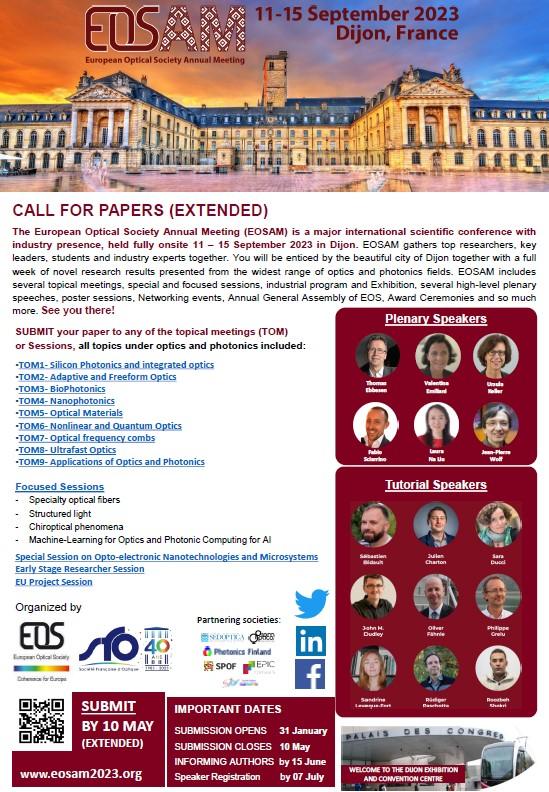SUBMISSION
Basic information
Submission opened on 31 January and closes on 10 May 2023 (extended from 14 April).
Submissions are accepted for oral and poster presentations, for all topical meetings and sessions. All topics under optics and photonics included.
Each topical meeting has their own program committee and chairs who will review the submissions. All accepted, presented abstracts with signed publication approval form will be added to the online, open access proceedings with DOI.
Best student presentations will be awarded.
SUBMIT: https://www.conftool.com/eosam2023

Download the Call for Papers
![]() Eosam cfp extended v2 (675.24 KB)
Eosam cfp extended v2 (675.24 KB)
Submission guidelines
Please follow these guidelines when submitting your abstract.
1) Submission Template
The abstract should be formatted according to the template provided (either LaTex or MS Word)
Submit the abstract as one camera-ready PDF file: 2-pages, A4 paper size, 2-columns, written in English. Please do not include links in your pdf.
LaTeX2e template
- Download Macropackage in LaTeX2e (146.54 KB)
Microsoft Word template
- Download Word template for abstracts (33.08 KB).
2) How to submit via Conftool
- Submit here: https://www.conftool.com/eosam2023
- Select the correct topical meeting ("TOM") or session in the submission phase. Double-check your choice.
- Choose preference for either oral or poster presentation (submission format).
- Select presenting author (this name will be added to the program). If no name is selected, the submitting author will be listed as the presenter by default.
- Choose "student presentation" if, and only if, the presenting author is a student. If you wish to qualify for the best student presentation, click the corresponding checkbox.
- Upload your 2-page abstract as a camera-ready pdf-file.
- Sign and upload the signed publication approval form (to be signed by at least one of the authors)
3) Other guidelines
- Instructions "How to prepare your article"
- Instructions "How to write title and abstract"
- Ethical rules
- General editorial guideline
Please note that your article might be checked in a plagiarism tool and that any ethical misconduct will be considered very seriously. Please make sure that all co-authors are aware of being listed in the paper and they have contributed to the work.
Proceedings
All accepted, presented abstracts with signed publication approval form will be added to the online, open access proceedings, published with EDP Sciences, in the Web of conferences, with DOI and indexation to CrossRef®, and added in the printed version of proceedings, published by Curran Associates. See the online proceedings from EOSAM 2022.
- 2-Page pdf abstracts that don't follow the publishing guidelines and templates, will not be included in the proceedings.
- Be careful, no extra corrections will be made after publication!
- Extra care should be taken when preparing the authors and reference lists:
- The online references within the proceedings will be linked to their original source, via CrossRef, ONLY IF the references are correctly presented.
- The submitting author is responsible for ensuring the abstract is created according to the template and guidelines provided
- If the signed publication approval form is not submitted, the abstract will NOT be included in the proceedings.
Please note:
Once a paper has been submitted online, the publisher (EDP Sciences) only permits changes in cases of serious scientific error. In those cases, an erratum or a note is published according to the practices of professional scientific publishing.
Publishing an erratum after online publication of the proceedings will be charged 300€ (Euros) per article by the publisher, except if the error is on the part of the Publisher.
Extended publication in JEOS:RP
After the conference, we offer you an opportunity to publish a revised/extended version of your proceedings manuscript in the special issue on
EOSAM 2023, published in the open-access Journal of the European Optical Society, JEOS:RP.
In addition to the Proceedings, the authors have an excellent opportunity to reach an even wider audience through publishing extended versions in this Special Issue.
